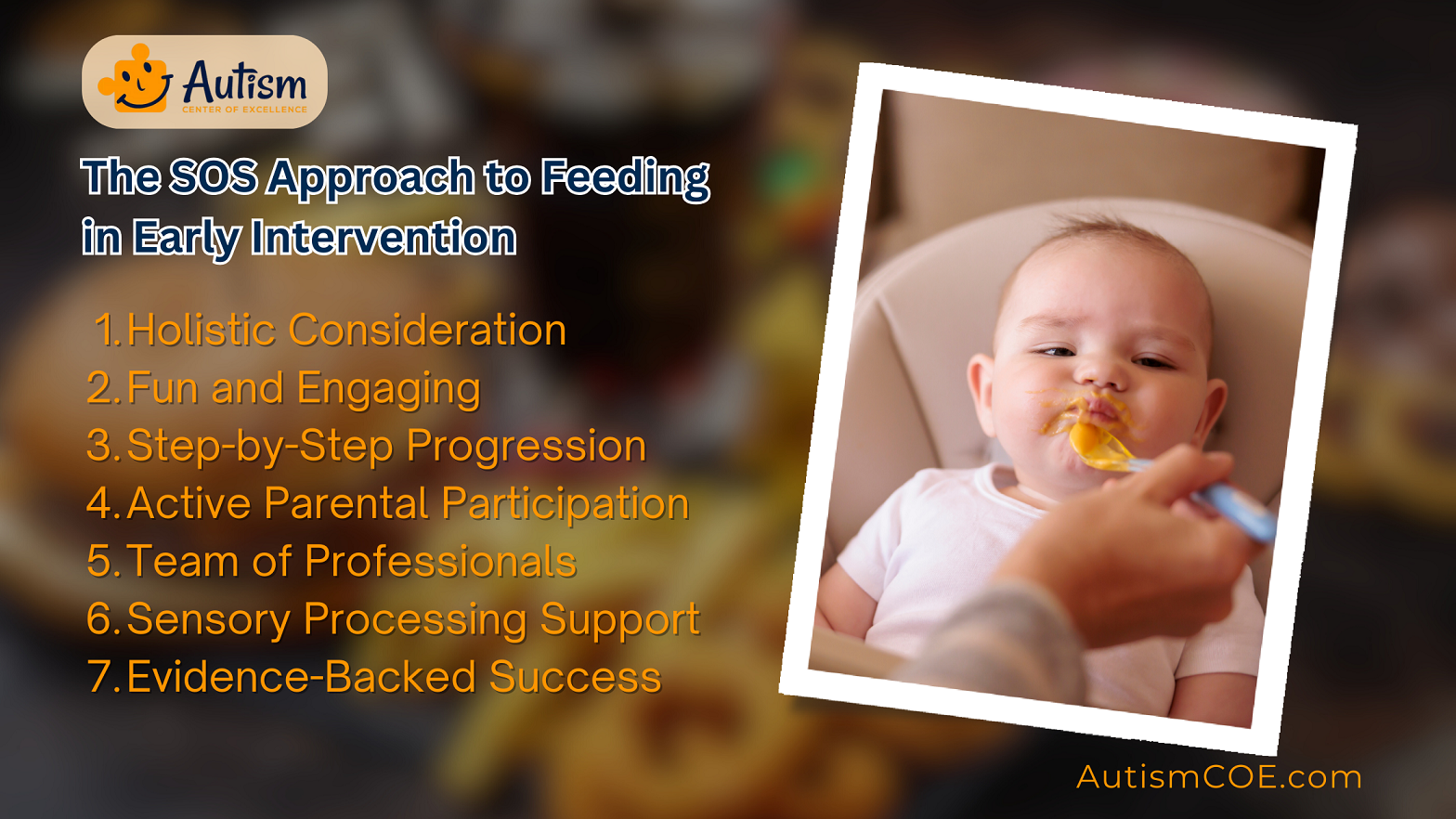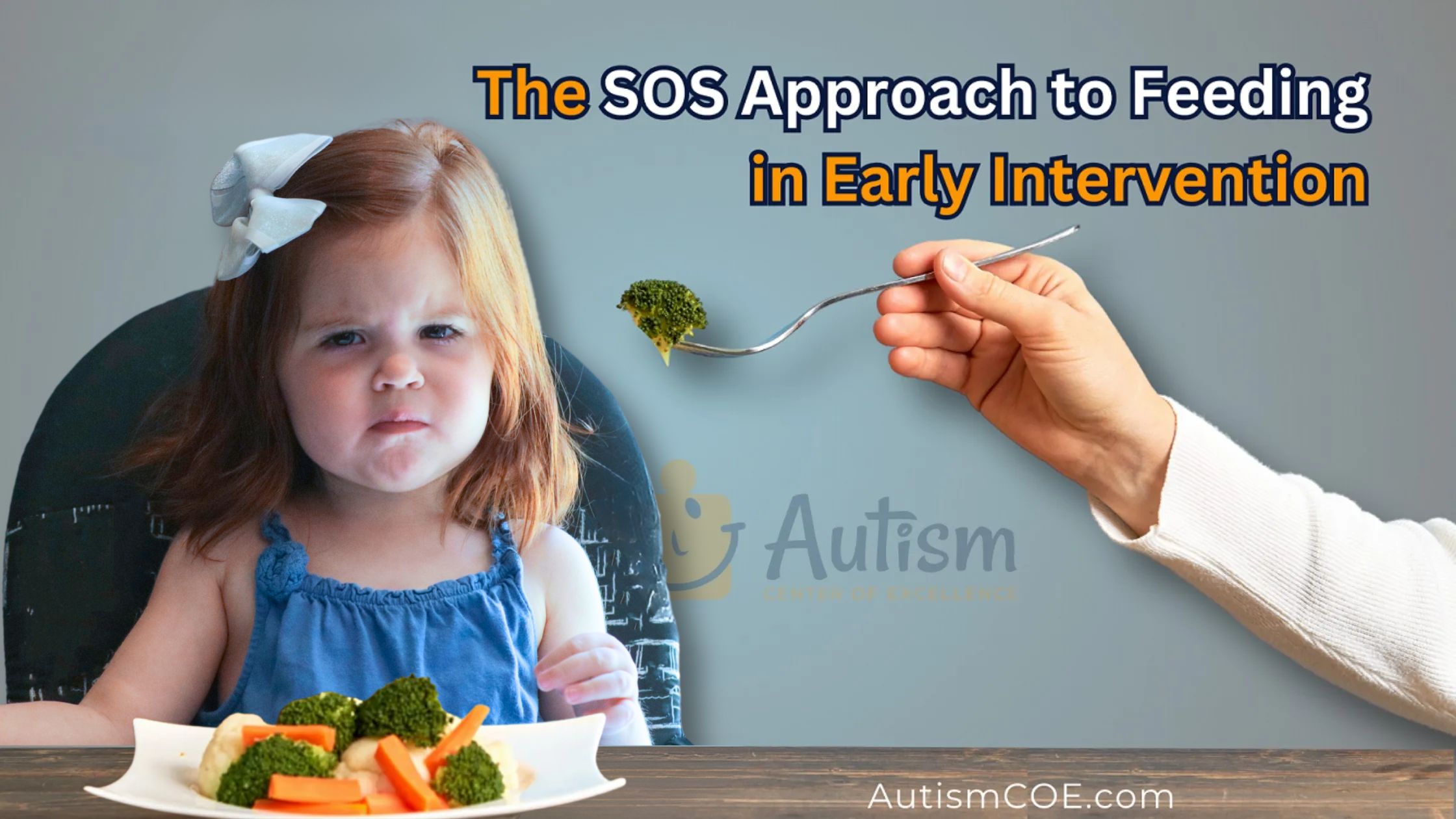Feeding Problems in Children with Autism: Feeding is one of the crucial concerns for many parents, it is worse when they are dealing with children with an Autism Spectrum Disorder (ASD). The Sensory Sensitivities and problems in the behavior of children with autism often intensify feeding problems, as a result limiting the range and amount of food that they consume and potentially leading to nutritional deficiencies. For the most part, such kids tend to be visually sensitive about the texture or color of the food, and in some cases, they may refuse to eat any food except a very limited amount of things. Here is where the SOS Approach to Feeding, a multidisciplinary program for feeding assessment and treatment particularly for fussy eaters, is applied.
The SOS feeding therapy is created specifically to meet these obstacles, and it offers both parents hope and a healthier life for their kids. In this blog, we will show how the SOS model for feeding therapy can be a key element of early intervention for toddlers with autism feeding issues.
What is the SOS Approach to Feeding?
The SOS Approach to Feeding, also called Sequential Oral Sensory feeding therapy, is a holistic, child-centered, and effective approach developed to deal with feeding problems in pediatric patients of all ages. It’s more than just teaching children how to eat. It implies factoring in the various eating experiences such as the food’s texture and taste in addition to the eating environment.
SOS feeding approach stands out by its attribute that concentrates on quality rather than quantity. Above all, it finds and maintains enjoyment in the whole eating experience. This approach breaks down each part of the eating process into manageable steps: food tolerance the presence of food, food interaction, food smell and food odor, food touch sensation, the taste of food, and finally eating food.
Through a healthy, lifelong, non-problematic approach to eating the SOS Approach to feeding has a solution for sensitivity to food and encourages families who might be going through feeding difficulties.

Why Would a Baby Needs Feeding Therapy?
Baby feeding therapy is a vital method of treatment for infants having issues with feeding. Here are five reasons why a baby might need feeding therapy:
🔸 Difficulty Swallowing (Dysphagia)
Infants with this condition are likely to choke, cough, or even gag during feedings and end up with poor weight gain or recurrent lung infections due to the food and liquids inhaled into the lungs.
🔸 Oral Sensory Issues
Some babies might be quite sensitive when it comes to the texture of the foods, flavors, and temperatures and often avoid the types or textures of certain foods, which expands the range of the baby’s diet.
🔸 Delayed Feeding Milestones
If a baby fails to meet standardized feeding milestones – for example, the failure to move from purees to solids – the therapist can help by suggesting an appropriate catch-up plan.
🔸 Failure to Thrive
In cases of babies that are not reaching the expected weight or growing by their age and gender, usually because of feeding problems, feeding therapy is helpful in case these babies receive enough nutrition.
🔸 Medical Conditions
Some medical conditions such as premature birth or neurological disorders, can make feeding difficult and this gives the indication of the need for feeding therapy.
Feeding therapy may prove an advantage for parents or caregivers of babies with nursing issues, but with it they will be able to ensure normal supply of nutrients to the child for his/her healthy growth and development.
SOS Feeding Therapy for Toddlers with Autism
The SOS (Sequential-Oral-Sensory) Approach to Feeding is exactly the kind of program you need if you have feeding issues. It’s research-backed and it’s been tailored specifically to children, including children diagnosed with Autism Spectrum. Unlike the traditional assessments that look at the ‘whole child’, this approach assesses not only the child’s oral motor features, but also the sensory, medical, and nutritional conditions as well as the environmental aspects. It understands that eating is an inborn sensory activity and applies food as a medium where the real ability to eat is acquired.
SOS Feeding Therapy for toddlers diagnosed with Autism is personalized as we recognize that there is no single protocol that works for everyone. The therapy sessions are modified to the individualized set of child necessities, including strategies that will make them master the skills they must to become an excellent spender. In this practice, we will be focusing particularly on children with Sensory Processing Disorder, which is rather a common issue among Children with Autism. Since the start of the SOS Approach to Feeding years ago, the SOS thesis has been clinically declared successful, thus making it possible for children to overcome their feeding concerns.

The SOS Approach to Early Intervention Feeding Therapy: An In-Depth Look
The SOS Approach to Early Intervention Feeding Therapy is a multidisciplinary approach for children with feeding difficulties in the age group of 0-5 years. It was created by Dr. Kay Toomey, a pediatric psychologist specializing in pediatric feeding disorders.
Holistic Consideration
The SOS approach takes into consideration the overall context for the “whole child.” Besides the swallowing capacity, it accounts for not only a child’s sensory responses but also the medical history, nutritional desired needs as well as environmental factors.
Fun and Engaging
This feeding remedial practice includes different games or child-friendly approaches that give out a new perspective on food mealtimes, hence reducing fear and stress.
Step-by-Step Progression
Usually, the children experience unfamiliar foods through a 32-step hierarchy. This gentle accustoming is helpful in getting children acquainted with the texture, smell, taste and appearance of different foods in the order of their preferences.
Active Parental Participation
The parents would be involved in the therapy sessions. Through their participation, this assists the parents with understanding the techniques used and the tool required to reinforce the progress at home.
Team of Professionals
Each member of the SOS team consists of a coordinated team of professionals. Occupational therapists, speech-language pathologists, and dietitians can be on a team that can work on a child’s feeding difficulty in different areas.
Sensory Processing Support
Sensory processing problems may impact children negatively, especially at mealtimes. The SOS approach involves a special program for this particular group of children who participate in a playful routine that teaches them to cope with the sensory aspects of food.
Evidence-Backed Success
The SOS approach to feeding is a 30-year-old model which, in time, has been proven effective in dealing with feeding difficulties in children and has succeeded, mainly, in treating the feeding problems of children with autism.
Join Our Weekly Newsletters!
Subscribe now to stay updated with our latest email updates.

ABA Feeding Intervention and SOS Approach
SOS (Sequential Oral Sensory) Approach and ABA (Applied Behavior Analysis) Feeding Intervention are two methods that are suitable for tackling feeding difficulties in children. The SOS Approach was created by Dr. Kay Toomey, which is ingrained in the unique, result-oriented clinical feeding program extensively used over 30 years with evidence of positive impact in both children and adults. It serves certain children with feeding and weight concerns (e.g., pediatric feeding and weight/growth problems) with a multidisciplinary team of professionals from relevant fields. The approach creates an atmosphere where children actively learn how to explore the food, starting with the fun way and that progresses in order to make them feel more comfortable.
ABA Feeding Intervention, however, utilizes behavioral principles to remedy feeding behavioral problems. However, various studies find SOS (Sensory Oral Sensory) as the alternative therapy for all behavioral feeding problems. A study comparing modified SOS approach (M-SOS) to ABA, displayed different effects of the intervention in the novel background on healthy target foods. Both approaches are meant to help children develop healthy feeding habits, however, they vary in the methods as well as the places where they are used. Parents who opt for one or the other usually make their decision based on the particular needs and the context of the child.
Frequently Asked Questions & Answer
What Does SOS Feeding Stand For?
SOS represents an acronym for sequential oral sensory. It is a style of therapy, that is employed in the area of nutritional help. It concentrates on the sensory aspect of eating. The SOS Approach evaluates and treats children with feeding and growth/weight-related problems at the same time; it looks upon all the aspects that may lead to these problems, such as sensory issues, motor skills, and behavioral challenges.
Is SOS Feeding Evidence-Based?
Yes, the SOS Approach to Feeding is an evidence-based methodology. It was created by Dr. Kay Toomey, who was a specialist in child psychology, and touches on several factors of sensory integration. There is an interdisciplinary approach where modalities are used together for individualized intervention and this research-backed method makes it a reliable one for treatment of eating issues.
How do I Know if My Baby Needs Feeding Therapy?
Signs that your baby needs feeding therapy are when he/she cannot swallow, coughs food several times refuses to eat or drink, growth is not progressing, or poor weight growth, and dislikes some food textures and types of food. In case you observe any of the mentioned symptoms, a medical specialist is recommended to carry out the full examination.
What is the Approach to Feeding Therapy in ABA?
The way to ensure feeding therapy in Applied Behavior Analysis (ABA) is through behavioral principles to solve the feeding issues. Here we mean the positive feedback when correct behaviors are observed, gradual introduction of new food types and teaching of feeding by self. ABA Therapy targets each child’s needs individually and therefore is highly tailored.
Conclusion
The SOS Approach to Feeding is a widely acclaimed and child-friendly treatment used in children with Autism Spectrum Disorders (ASD) and that is highly valuable during the early intervention. This strategy echoes the intimate child’s relationship with food and enables the development of a natural sense of curiosity and exploratory traits. At the same time though, every child is an individual, and that which is effective for one may not suit the other. Hence, on the one hand, it is imperative that caregivers as well as professionals come together and design tailor-made plans that suit each child’s special needs, and on the other hand, caring community support is essential so that the whole process can be easy for everyone. A lot of patience, consistency, and the right approach are the things needed to help children with ASD cope with eating issues and ever their feeding. Subsequently, it is a great contribution to their health and well-being.
Please Note: The content of this blog is for informational purposes only and should not be considered a substitute for professional medical advice, diagnosis, or treatment. Consult a qualified healthcare professional for personalized guidance tailored to your specific situation.

Bhavika Bhasin
Bhavika Bhasin is the Research and Marketing officer at AutismCOE. She works with children and adults with ASD. Her clinical research includes evaluating various available autism screening and diagnosis methods and their efficacy. She is currently developing a novel screening exam that is indicated to be more accurate than the existing available exams. She is also writes articles papers for various publications.


